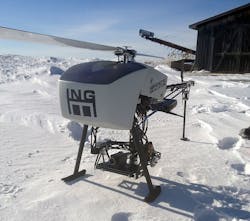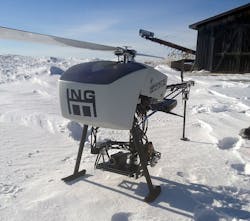Alaska Center for Unmanned Aircraft Systems Integration selects VTOL UAS from ING Robotic Aviation
OTTAWA, Ontario, 16 Dec. 2014. Officials at the Alaska Center for Unmanned Aircraft Systems Integration (ACUASI) sought a robotic aircraft, also known as a drone, for research into systems integration and specific unmanned aircraft systems (UAS) applications, as well as to increase the center’s focus on robust Arctic-proven technology. They found their solution at ING Robotic Aviation: the company's Responder rotary-wingunmanned aerial vehicle (UAV) system.
ING Robotic Aviation has sold two complete Responder vertical take-off and landing (VTOL) robotic aircraft with sensors, as well as a Ground Control System (GCS) and ancillary equipment, to ACUASI. The company is also providing a two-week training package.
"After researching available systems that met our performance and payload integration requirements, we determined that the Responder was the best solution, and actually exceeds our weather, robustness and payload lift requirements," explains ACUASI Director Marty Rogers.
"This is also a first step in developing a partnership with ING Robotic Aviation. They have extensive experience in operating in difficult conditions, and take a serious, aviation company approach to both their technology and operations. These are people we can work with."
The Responder, equipped with its stabilized, gimbal-mounted camera systems, can provide real-time still and video images in both visual and infrared sections of the spectrum. Mosaicking and the production of 3D imagery are readily possible, officials say; further, the system’s flexibility allows for future technology advancements such as integration of new sensors.
"ACUASI knows what they are doing. They have a deep understanding of systems, payloads and applications. This is an organization that we are very interested in cooperating with, and it is an honour that they have selected Responder as their next system," says Ian Glenn, CEO and CTO of ING Robotic Aviation. "We are looking forward to continuing to work with them on a range of northern applications for UAVs."
ING Robotic Aviation delivers robust, flexible, turnkey aerial remote sensing solutions as comprehensive products and end-to-end services. “We put the right information in our customers' hands at the right time. It's all about the data. We developed our skills through extensive operational unmanned aircraft system (UAS) surveillance work with the Canadian military. From these beginnings with military systems, we now provide commercial services with robotic aircraft including mapping, inspections and monitoring in North America and internationally. We are at the forefront of a disruptive technological and operational change, focused on reinventing aviation,” says a company representative.
The Alaska Center for Unmanned Aircraft Systems Integration, RDT&E, or ACUASI, was established in December 2012 by the University of Alaska Board of Regents in recognition of the importance and growth of the unmanned aircraft program. It was established under the University of Alaska Fairbanks in the Geophysical Institute where it originated but was given the role of leading all unmanned aircraft programs for the entire system. It was also tasked to pursue opportunities with the FAA, such as the FAA test sites. The program originated in 2001, and over the years had expanded its scope, the equipment it operated, and the variety and complexity of research projects it executed. In 2013 ACUASI submitted its proposal to the FAA for one of the six test sites established by the 2012 FAA Modernization and Reform Act, and in December 2013 the FAA announced that the University had been selected. The Pan Pacific UAS Test Range Complex reports to the ACUASI, but also includes principal partners in Oregon and Hawaii as well as 56 non-state partners located all over the US and internationally. Ranges are located in the three states as well as in Iceland, a key international partner.

